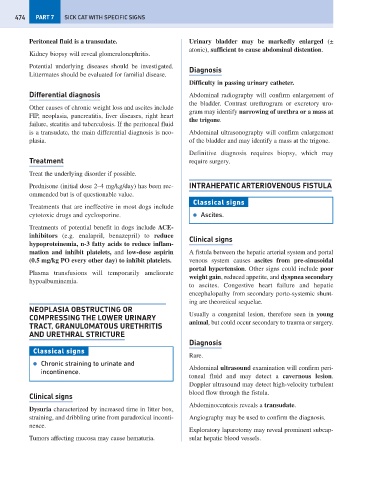Page 482 - Problem-Based Feline Medicine
P. 482
474 PART 7 SICK CAT WITH SPECIFIC SIGNS
Peritoneal fluid is a transudate. Urinary bladder may be markedly enlarged (±
atonic), sufficient to cause abdominal distention.
Kidney biopsy will reveal glomerulonephritis.
Potential underlying diseases should be investigated.
Diagnosis
Littermates should be evaluated for familial disease.
Difficulty in passing urinary catheter.
Differential diagnosis Abdominal radiography will confirm enlargement of
the bladder. Contrast urethrogram or excretory uro-
Other causes of chronic weight loss and ascites include
gram may identify narrowing of urethra or a mass at
FIP, neoplasia, pancreatitis, liver diseases, right heart
the trigone.
failure, steatitis and tuberculosis. If the peritoneal fluid
is a transudate, the main differential diagnosis is neo- Abdominal ultrasonography will confirm enlargement
plasia. of the bladder and may identify a mass at the trigone.
Definitive diagnosis requires biopsy, which may
Treatment require surgery.
Treat the underlying disorder if possible.
Prednisone (initial dose 2–4 mg/kg/day) has been rec- INTRAHEPATIC ARTERIOVENOUS FISTULA
ommended but is of questionable value.
Classical signs
Treatments that are ineffective in most dogs include
cytotoxic drugs and cyclosporine. ● Ascites.
Treatments of potential benefit in dogs include ACE-
inhibitors (e.g. enalapril, benazepril) to reduce
Clinical signs
hypoproteinemia, n-3 fatty acids to reduce inflam-
mation and inhibit platelets, and low-dose aspirin A fistula between the hepatic arterial system and portal
(0.5 mg/kg PO every other day) to inhibit platelets. venous system causes ascites from pre-sinusoidal
portal hypertension. Other signs could include poor
Plasma transfusions will temporarily ameliorate
weight gain, reduced appetite, and dyspnea secondary
hypoalbuminemia.
to ascites. Congestive heart failure and hepatic
encephalopathy from secondary porto-systemic shunt-
ing are theoretical sequelae.
NEOPLASIA OBSTRUCTING OR
COMPRESSING THE LOWER URINARY Usually a congenital lesion, therefore seen in young
TRACT, GRANULOMATOUS URETHRITIS animal, but could occur secondary to trauma or surgery.
AND URETHRAL STRICTURE
Diagnosis
Classical signs
Rare.
● Chronic straining to urinate and
Abdominal ultrasound examination will confirm peri-
incontinence.
toneal fluid and may detect a cavernous lesion.
Doppler ultrasound may detect high-velocity turbulent
blood flow through the fistula.
Clinical signs
Abdominocentesis reveals a transudate.
Dysuria characterized by increased time in litter box,
straining, and dribbling urine from paradoxical inconti- Angiography may be used to confirm the diagnosis.
nence.
Exploratory laparotomy may reveal prominent subcap-
Tumors affecting mucosa may cause hematuria. sular hepatic blood vessels.

